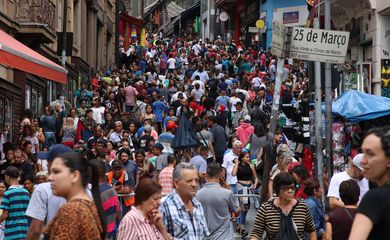Brazilian population likely to start shrinking in 2042

The Brazilian population will begin to decline in 2042, as per projections published Thursday (Aug. 22) by statistics bureau IBGE. As a result, in 2041, Brazil should reach its maximum number of inhabitants, estimated at 220.43 million people.

According to the data, the rate of population increase—which in 2024 should be around 0.4 percent—is expected to decrease little by little until 2041. From 2042 onwards, the rate of population decline should also slow down gradually and near 0.7 percent per year in 2070, when the nation’s total population should stand at 199.23 million.
“At the beginning of the 2000s, we had a growth rate of more than one percent. Now we’re approaching zero. When it comes to Brazil, this is mainly due to the balance of births and deaths. At that point [in 2042], the number of deaths would exceed births,” IBGE researcher Marcio Minamiguchi noted.
The previous forecast, from 2020, was that the Brazilian population would only begin to shrink in 2048, after reaching a peak of 233.23 million people in 2047—in other words, nearly 13 million more and six years later than the new projection.
The projections stem from IBGE’s new population estimates, based in turn on data from the 2000, 2010, and 2022 Censuses, the Census Post-Enumeration Survey, and post-pandemic birth, death, and migration records.
It is now estimated, for example, that Brazil’s population was 210,862,983 on July 1, 2022—up from the 203 million initially calculated by the 2022 Census, an adjustment of 3.9 percent.
Replacement
According to Minamiguchi, the population decline is linked to the reduction in the fertility of Brazilian women. In 2023, the rate was 1.57 children per woman, well below what is seen as adequate for population replacement (2.1 children per woman).
In 2000, Brazil exceeded this rate, with 2.32 children per woman, which hinted at a growth for the following decades. Five years later, the rate had fallen to 1.95 children, rising to 1.75 in 2010, 1.82 in 2015, and 1.66 in 2020.
“This fall in fertility has a longer history. It gained momentum in the mid-1960s. Just to give you an idea, in 1960 the rate was 6.28 children per woman,” said IBGE researcher Marla França.
Among the Brazilian states, only Roraima still has a fertility rate above replacement level in 2023—2.26 children per woman. The lowest rate was in Rio de Janeiro (1.39).
Fertility in Brazil is expected to continue to fall until 2041, when it should reach 1.44 children per woman, after which it should increase slightly until 2070, when it is likely to number 1.5.
The number of births each year, which was 3.6 million in 2000, rose to 2.6 million in 2022, and should total 1.5 million in 2070.






